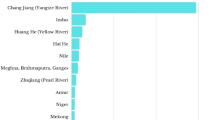Abstract
Nuclepore filters of 0.6–1.0μm pore size have been used to prepare “protist-free” water for a number of studies in microbial ecology. This procedure has been called into question by a recent study claiming that a significant portion of bacterial loss in filtrates could be due to uncharacterized predators passing through 0.6μm filters. We were unable to directly observe protists in 0.6μm filtrates using phase contrast, epifluorescence, or transmission electron microscopy. Using the culture techniques of rice grain enrichment and most probable number, however, we were able to observe and quantify several species of bacterivorous nanoflagellates that developed not only in 0.6μm, but also in 0.4μm seawater filtrates. The ability of predacious nanoflagellates to squeeze through bacteria-sized pores questions studies of bacterial production and chemical cycling that have assumed protist-free filtrates.
Similar content being viewed by others
References
Ammerman JW, Fuhrman JA, Hagstrom A, Azam F (1984) Bacterioplankton growth in seawater: I. Growth kinetics and cellular characteristics in seawater cultures. Mar Ecol Prog Ser 18:31–39
Ballew HW, Staff of Nuclepore Corporation (1978) Basics of filtration and separation. Nuclepore Corp, p 8
Beers JR, Stewart GL (1970) Numerical abundance and estimated biomass of microzooplankton. Bull Scripps Inst Oceanogr 17:67–87
Brooker BE, Ogden CG (1972) Encystment ofBodo caudatus. Protoplasma 74:397–409
Burney CM, Davis PG, Johnson KM, Sieburth JMcN (1981) Dependence of dissolved carbohydrate concentrations upon small scale nanoplankton and bacterioplankton distributions in the Western Sargasso Sea. Mar Biol 65:289–296
Burney CM, Davis PG, Johnson KM, Sieburth JMcN (1982) Diel relationships of microbial trophic groups andin situ dissolved carbohydrate dynamics in the Caribbean Sea. Mar Biol 67:311–322
Caron DA (1983) Technique for enumeration of heterotrophic and phototrophic nanoplankton, using epifluorescence microscopy, and comparison with other procedures. Appl Environ Microbiol 46:491–498
Caron DA, Davis PG, Madin LP, Sieburth JMcN (1982) Heterotrophic bacteria and bacterivorous protozoa in oceanic macroaggregates. Sci 218:795–797
Christian RR, Hanson RB, Newell SY (1982) Comparison of methods for measurement of bacterial growth rates in mixed batch cultures. Appl Environ Microbiol 43:1160–1165
Clarke KR, Owens NJP (1983) A simple and versatile micro-computer program for the determination of ‘most probable number.’ J Microbiol Methods 1:133–137
Davis PG, Sieburth JMcN (1982) Differentiation of phototrophic and heterotrophic nanoplankton populations in marine waters by epifluorescence microscopy. Ann Inst Oceanogr 58(S):249–260
Davis PG, Sieburth JMcN (1984) Estuarine and oceanic microflagellate predation of actively growing bacteria: estimation by frequency of dividing-divided bacteria. Mar Ecol Prog Ser 19: 237–246
Estep KW, Hargraves PE, Davis PE, Sieburth JMcN (1984) Chloroplast-containing microflagellates in natural populations of North Atlantic nanoplankton: their identification and distribution, including a description of five new species ofChrysochromulina (Prymnesiophyceae). Protistologica 20:613–634
Fenchel T (1982) Ecology of heterotrophic microflagellates. II. Bioenergetics and growth. Mar Ecol Prog Ser 8:225–231
Fenchel T (1982) Ecology of heterotrophic microflagellates. III. Adaptations to heterogeneous environments. Mar Ecol Prog Ser 9:25–33
Fenchel T (1982) Ecology of heterotrophic microflagellates. IV. Quantitative occurrence and importance as bacterial consumers. Mar Ecol Prog Ser 9:35–42
Fuhrman JA, Azam FA (1980) Bactcrioplankton secondary production estimates for coastal waters of British Columbia, Antarctica, and California. Appl Environ Microbiol 39:1085–1095
Fuhrman JA, McManus GB (1984) Do bacteria-sized marine eukaryotes consume significant bacterial production? Sci 224:1257–1260
Hagström A, Ammerman JW, Henrichs S, Azam F (1984) Bacterioplankton growth in seawater. II. Organic matter utilization during steady-state growth in seawater cultures. Mar Ecol Prog Ser 18:41–48
Hobbie JE, Daley RJ, Jasper S (1977) Use of Nuclepore filters for counting bacteria by fluorescence microscopy. Appl Environ Microbiol 33:1225–1228
Johnson PW, Sieburth JMcN (1982) In-situ morphology and occurrence of eucaryotic phototrophs of bacterial size in the picoplankton of estuarine and oceanic waters. J Phycol 18: 318–327
Kopylov AI, Moiseev ES (1980) Effect of colorless flagellates on the determination of bacterial production in seawater. Doklady Biol Sci 252:272–274
Li WKW, Scubba Rao DV, Harrison WG, Smith JC, Cullen JJ, Irwin B, Platt T (1983) Autotrophic picoplankton in the tropical ocean. Sci 219:292–295
Lighthart B (1969) Planktonic and benthic bacterivorous protozoa at eleven stations in Puget Sound and adjacent Pacific Ocean. J Fish Res Bd Can 26:299–304
Newell SY, Christian RR (1981) Frequency of dividing cells as an estimator of bacterial productivity. Appl Environ Microbiol 42:23–31
Platt T, Subba Rao DV, Irvin B (1983) Photosynthesis of picoplankton in the oligotrophic ocean. Nature 301:702–704
Sieburth JMcN (1979) Sea microbes. Oxford University Press, New York, pp 112–114
Sieburth JMcN, Smetacek V, Lenz J (1978) Pelagic ecosystem structure: heterotrophic compartments and their relationship to plankton size fractions. Limnol Oceanogr 23:1256–1263
Sorokin YI (1979) Zooflagellates as a component of the community of eutrophic and oligotrophic waters in the Pacific Ocean. Oceanology 19:316–319
Takahashi M, Hori T (1984) Abundance of picoplankton in the subsurface chlorophyll maximum layer in subtropical and tropical waters. Mar Biol 79:177–186
Author information
Authors and Affiliations
Rights and permissions
About this article
Cite this article
Cynar, F.J., Estep, K.W. & Sieburth, J.M. The detection and characterization of bacteria-sized protists in “Protist-free” filtrates and their potential impact on experimental marine ecology. Microb Ecol 11, 281–288 (1985). https://doi.org/10.1007/BF02016812
Issue Date:
DOI: https://doi.org/10.1007/BF02016812




